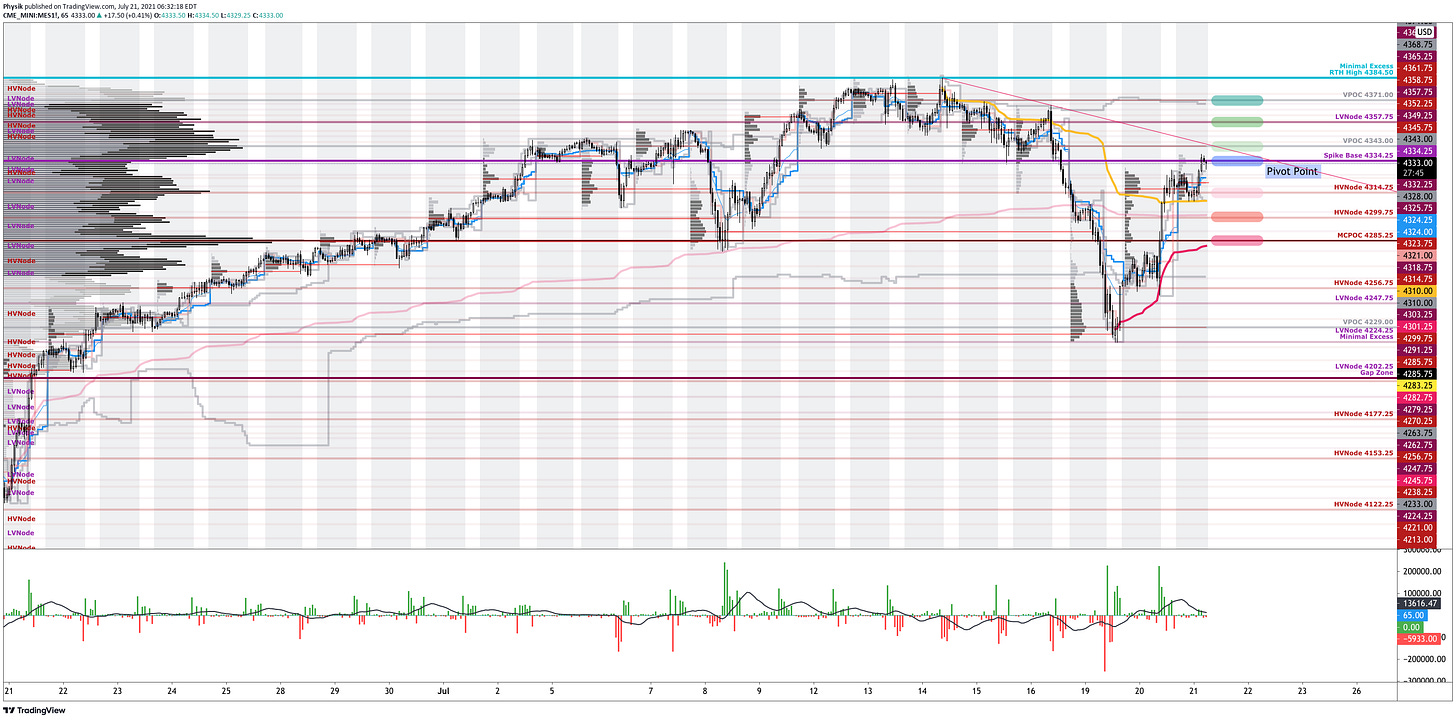Market Commentary
Equity index futures sideways to higher overnight.
Pandemic continues to accelerate.
Ahead is oil market data, earnings.
Indices sideways as volatility ebbs.
What Happened: U.S. stock index futures auctioned sideways to higher alongside an increased spread of COVID-19 variants, earnings, and tremendous bond market volatility.
The trade comes also as leading indicators for global economic growth show unusually strong readings, according to Merrill, “pointing to one of the strongest economic expansions of the past 70 years.” In line, strategists at JPMorgan Chase & Co (NYSE: JPM) revised higher their year-end S&P 500 price target from $4,400 to $4,600.
Ahead, participants are looking forward to data on oil market inventory and earnings.

What To Expect: As of 6:30 AM ET, Wednesday’s regular session (9:30 AM - 4:00 PM EST) in the S&P 500 will likely open on a small gap, just outside of prior-range and -value, suggesting a potential for directional opportunity.
Balance-Break and/or Gap Scenarios: Monitor for acceptance (i.e., more than 1-hour of trade) outside of the balance area.
Gaps ought to fill quickly. Should they not, that’s a signal of strength; do not fade. Leaving value behind on a gap-fill or failing to fill a gap (i.e., remaining outside of the prior session’s range) is a go-with indicator.
Auctioning and spending at least 1-hour of trade back in the prior range suggests a lack of conviction; in such a case, do not follow the direction of the most recent initiative activity.
Adding, during the prior day’s regular trade, the best case outcome occurred, evidenced by trade above the $4,285.25 micro-composite Point of Control (MCPOC). This is significant because it denotes movement above the fairest price to do business since the June 20 swing low. Now, initiative sellers have a clear line in the sand – $4,285.25 – when it comes to making headway into areas of demand.
Further, the near-vertical price rise wasn’t without a warrant.
After breaking down, the S&P 500 came to a micro-composite LVNode and halted. Thereafter, prices rebounded. Why was this? Stock indexes were positioned for a vicious rebound as near-term downside discovery may have reached a limit, based on market liquidity metrics and the inventory positioning of participants.
According to SqueezeMetrics, the steepness of the GammaVol (GXV) curve suggested there was more risk to the upside than the downside, at that S&P 500 juncture.


Given this metric, strong breadth, and positive delta, as well as the resolve of a Volume Weighted Average Price (VWAP) pinch, the S&P 500 is positioned for higher.

Volume-Weighted Average Prices (VWAPs): A metric highly regarded by chief investment officers, among other participants, for quality of trade. Additionally, liquidity algorithms are benchmarked and programmed to buy and sell around VWAPs.
For today, participants can trade from the following frameworks.
In the best case, the S&P 500 trades sideways or higher; activity above the $4,334.25 spike base puts in play the $4,343.00 untested Point of Control (VPOC). Initiative trade beyond the VPOC could reach as high as the $4,357.75 low volume area (LVNode) and $4,371.00 VPOC.
In the worst case, the S&P 500 trades lower; activity below the $4,334.25 spike base puts in play the $4,314.75 HVNode. Initiative trade beyond the $4,314.75 HVNode could reach as low as the $4,299.75 HVNode and $4,285.25 micro-composite POC.
Spikes: Spike’s mark the beginning of a break from value. Spikes higher (lower) are validated by trade at or above (below) the spike base (i.e., the origin of the spike).
POCs: POCs are valuable as they denote areas where two-sided trade was most prevalent. Participants will respond to future tests of value as they offer favorable entry and exit.
Volume Areas: A structurally sound market will build on past areas of high volume. Should the market trend for long periods of time, it will lack sound structure (identified as a low volume area which denotes directional conviction and ought to offer support on any test).
If participants were to auction and find acceptance into areas of prior low volume, then future discovery ought to be volatile and quick as participants look to areas of high volume for favorable entry or exit.
News And Analysis
Work-in-progress U.S. infrastructure bill faces test in Senate. (REU)
Housing starts continuing to improve as permits lose ground. (MND)
Nasdaq to spin out market for pre-IPO shares in a bank deal. (WSJ)
Decentralized finance builds on three major waves of bitcoin. (Future)
Startups on a record acquisition spree buying other startups. (CBN)
U.S. and European consumer confidence and spending rise. (Moody’s)
Titan – Fidelity for Millennials – raised $58M Series B round. (CBN)
Survey showing U.S. majority supports more tech regulation. (Axios)
What People Are Saying


About
After years of self-education, strategy development, and trial-and-error, Renato Leonard Capelj began trading full-time and founded Physik Invest to detail his methods, research, and performance in the markets. Additionally, Capelj is a finance and technology reporter. Some of his biggest works include interviews with leaders such as John Chambers, founder and CEO, JC2 Ventures, Kevin O’Leary, businessman and Shark Tank host, Catherine Wood, CEO and CIO, ARK Invest, among others.
Disclaimer
At this time, Physik Invest does not manage outside capital and is not licensed. In no way should the materials herein be construed as advice. Derivatives carry a substantial risk of loss. All content is for informational purposes only.








